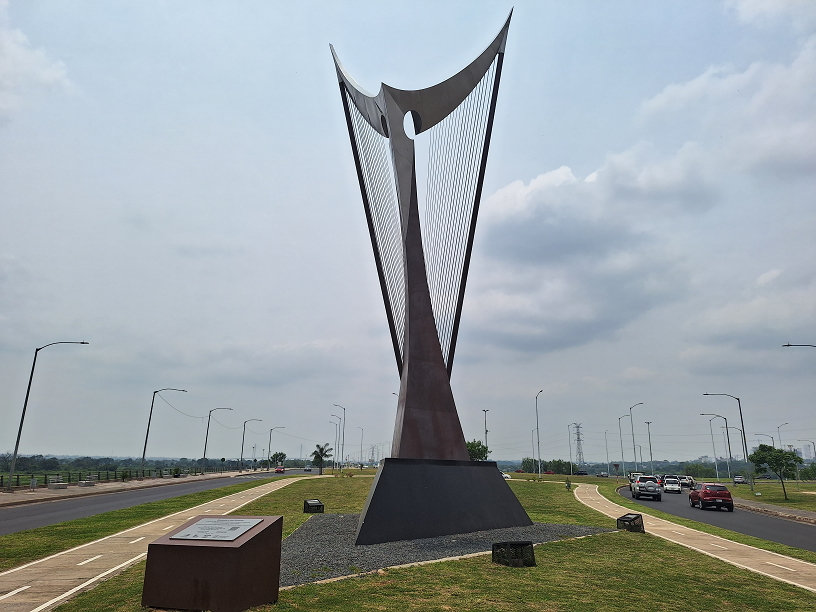In June 2023 a 15 metre tall statue of a harp was installed along the Costanera in Asuncion.
This is a monument to the Paraguayan harp the national instrument of Paraguay.
The statue is made of metal and being positioned along the road leading from the airport to Asuncion city centre is one of the first images of Paraguay many visitors will see.
It was built as both a monument to the country’s national instrument and to pay homage to Felix Perez Cardozo.
Felix Perez Cardozo (1908-1952) was one of the best know harpists and a composer of many pieces of music for it.
The monument itself was made by the artist Junapi Pistilli.
On the day of the installation of the monument a large festival of Paraguayan harp music was held on the lawn in front of it.
The Monument to the Paraguayan Harp has become a popular place to visit and take photos. There is even a stand to hold the phones of those wishing to take a selfie with the harp.
Roots of the Paraguayan Harp can be traced back to the arrival of Christian missionaries with the Spanish.
They sought to bring religion along with some of their European culture to the Guarani of Paraguay.
It was the Franciscans who first noticed the natural musical talents of the Guarani. They taught them an number of instruments to be played alongside the singing of hymns. Of all these it was in the harp that the Guarani found the greatest mastery.
Once the missionaries departed the Guarani did not disguard all they had bought with them. The harp they retained and it soon found a central role in their culture.
To their myths and legends it gave a musical backing. Thus becoming as interwoven with their lives as the tales it’s players told.
The Paraguayan harp had also by this time developed its distinctive look and sound. This makes it a little different from the European harps such as the Irish one from which it is ultimately derived.
A wooden Paraguayan harp stands about 5 feet tall and weighing about 10 pounds is somewhat lighter than a European harp. This makes it easier for it’s owner to carry from one performance to the next.
All Paraguayan harps though are not made equal. In terms of strings a harp may have a few as 32 or as many as 46.
These strings are lightly strung and plucked with the fingernails.
For a long time the sound of the harp resonated solely within Paraguay’s borders. Then between the 1930s and 1950s it broke out beyond Paraguay. During that time a number of professional harpist took the sound of the Paraguayan harp all around the world.
This heightened exposure did not though dilute the cultural significance of the harp. The tunes these performers played remained the ones they had bought with them from Paraguay.
A few of these tunes such as Pajaro Campana and La Missonera have become staples of the harp and are preformed whenever there is a recital.
Most tunes though remain unwritten. These are passed orally from master to student with anyone free to make their own additions.
The great majority of these tunes covers themes of national identity and Paraguayan pride. Accordingly there is often a need for new tunes to be written for subjects as diverse as football teams and politicians.
Styles of music for which Paraguayan harp music is most often written are Polka Paraguayas and Guaranies. Both of which provide music to dance to. The soundtrack to many traditional Paraguayan dances.
For a long time the playing of the harp was very much a male occupation. Even now bands of travelling musicians will almost always be all male.
It was not until the late 20th century that woman took up harp playing. Very different from the image of the female European harpist.
Now though although harp playing remains mostly a male preserve there are a number of women playing harps to the highest standard.
Almost no event from a family gathering to a national festival is complete without a Paraguayan harp and the Paraguayan dancing that often accompanies it.
Being such an important part of Paraguayan culture it is only natural that it has a day given over to it every year. 9th June is the National Day of the Harp.
If you are seeking the true sound of Paraguay you need look no further than that of the Paraguayan harp.


Recent Comments